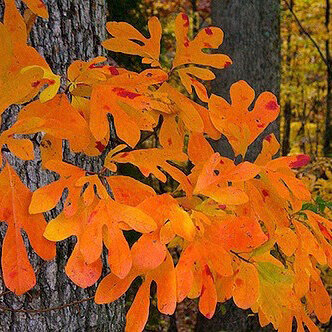10 trees with amazing fall color
By TJ Nagel
I was recently pruning trees in a newer neighborhood on the east side of Columbus where every house had two red maple in the front yard. Although Red maple is a native tree to Ohio, this subdivision was planted with a cultivated variety of the species called ‘Red Sunset.’ ‘Red Sunset’ red maple was selected and well marketed for its compact habit, good branching structure and most notably for its showy and reliable orange to red fall color.
Unfortunately for most of us in the central Ohio area, ‘Red Sunset’ Red maple was selected in Oregon and requires an acid soil with consistent moisture to perform well. It does not like the dry and often high pH soils of our urban landscapes.
The trees I observed on the East side of town had just been planted in the last 12-15 years, were in poor health & vigor and were already expressing advanced symptoms of chlorosis, a nutrition deficiency that causes yellowing, stunted growth, decline and eventual plant death.
Chlorosis in a Red Maple
I learned about chlorosis in different Red maple cultivars (short for cultivated varieties) when I was a horticulture student at OSU and I still deal with it daily in my career as an arborist. I see chlorotic Red maple in parks, commercial buildings, along streets and in private gardens every day. I even see chlorotic red maple in the aisles of reputable nurseries.
How has this tree become so popular? I believe it’s because it has been so well marketed. Maple has name recognition amongst most folks and the nursery industry loves red maple because it is easy to propagate, and they can produce a sellable tree from small whip in a short amount of time.
When I have the opportunity to ask clients why they selected this tree for their landscape I generally get one the following responses.
Somewhat common: Name recognition, they admit they don’t know much about trees, but they remember maple being a good tree from their childhood.
More common: Their landscaper recommended it (interesting side note: I have yet to hear from anyone that their arborist recommended it).
Most common: They were looking for something with nice fall color.
I’m a sucker for some nice fall color also and I’m here to report there are a lot of other great alternatives to red maple when looking for trees with nice fall foliage. The following are some of my favorite fall color trees that are adaptable, urban tolerant, and easy to grow.
Valley Forge American Elm
Great fast-growing historic shade tree adaptable to most soil types – reliable yellow to gold fall color.
Japanese Zelkova
Another urban tolerant medium to fast growing shade tree with nice vase shaped canopy with yellow to apricot to red fall color.
Black Tupelo
Excellent tree for glossy red fall color. Some cultivars will color yellow and red. Slow growing medium sized tree.
Hickory
This image is of a Pignut hickory but most species of hickory color beautifully in the fall. Slow growing tree. Plant this one for the next generation. Great tree for wildlife.
Sassafrass
Medium sized fast-growing tree in youth. Great yellow to orange to red to purple fall color – can be variable from year to year. One of Ohio’s most outstanding native trees for fall foliage.
Witch Hazel
There are dozens of cultivars of witch-hazel. Most of them have showy fall color. This image is the fall foliage of ‘Diane’ witch-hazel, one of my favorites. Also has showy red flowers in late winter.
Kousa dogwood
Great ornamental tree with exceptional yellow to red fall color. Also has great flowering show, beautiful bark at maturity and interesting fruit.
Ginkgo
Unrivaled for golden yellow fall color. My only complaint is that the show is short lived, often only 2 – 3 days.
Dawn Redwood
Foliage turns an excellent copper orange to brown before leaf drop. Fast growing, significant pest and disease-free shade tree.
Japanese Katsura
Medium to fast growing shade tree. Fall color can be apricot to scarlet red. Fall leaves smell like cotton candy.
TJ Nagel | Production Manager, Russell Tree Experts
ISA Certified Arborist® OH-6298A // Graduated from The Ohio State University in 2012, Earned B.S. in Agriculture with a major in Landscape Horticulture and minor in Entomology // Tree Risk Assessment Qualified (TRAQ) // Russell Tree Experts Arborist Since 2010
[images courtesy of various providers]













